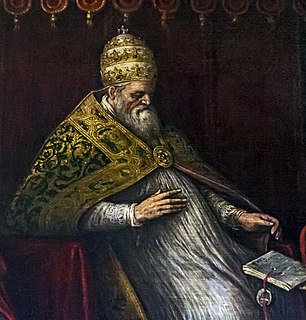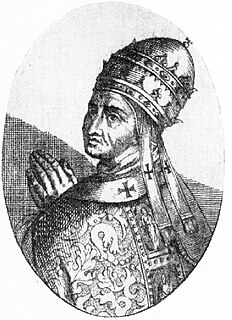
Pope Benedict XI, born Nicola Boccasini, was Pope from 22 October 1303 to his death on 7 July, 1304. He was also a member of the Order of Preachers.

Pope Innocent V, born Pierre de Tarentaise, was pope from 21 January to 22 June 1276. He was a member of the Order of Preachers and was a close collaborator of Pope Gregory X during his pontificate. He was beatified in 1898 by Pope Leo XIII.
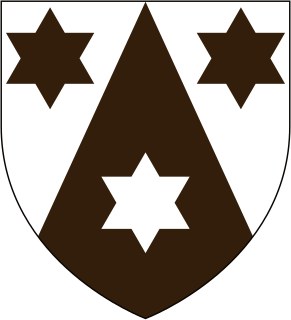
The Order of the Brothers of the Blessed Virgin Mary of Mount Carmel or Carmelites is a Roman Catholic mendicant religious order founded, probably in the 12th century, on Mount Carmel in the Crusader States, hence the name Carmelites. However, historical records about its origin remain very uncertain. Berthold of Calabria has traditionally been associated with the founding of the order, but few clear records of early Carmelite history have survived.

Albert Auguste Gabriel Hanotaux, known as Gabriel Hanotaux was a French statesman and historian.
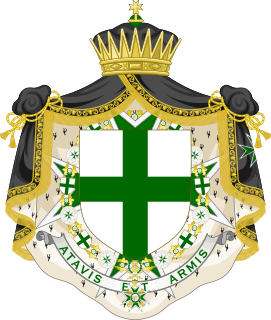
The Order of Saint Lazarus of Jerusalem, also known as the Leper Brothers of Jerusalem or simply as Lazarists, was a Catholic military order founded by crusaders around 1119 at a leper hospital in Jerusalem, Kingdom of Jerusalem, whose care became its original purpose, named after their patron saint, Lazarus. It was recognised by King Fulk of Jerusalem in 1142 and canonically recognised as hospitaller and military order of chivalry under the rule of Saint Augustine in the Papal bull Cum a Nobis Petitur of Pope Alexander IV in 1255. Although they were centered on their charism of caring for those afflicted with leprosy, the knights of the Order of Saint Lazarus notably fought in the Battle of La Forbie in 1244 and in the Defense of Acre in 1291. The titular seat was successively situated at Jerusalem, Saint-Jean-d'Acre and - after the fall of the Kingdom of Jerusalem - split in two main branches in Italy and in Château Royal de Boigny-sur-Bionne in France.
Diego de Acebo was bishop of Osma from 1201 to 1207.

The Monastery of Notre-Dame-de-Prouille or Prouilhe, is the "cradle of the Dominicans", where the first Dominican house, a monastery of nuns, was founded in late 1206 or early 1207. It is located in a hamlet in Languedoc, France, lying between Fanjeaux and Bram, at the point where the road from Castelnaudary to Limoux crosses the road from Bram to Mirepoix.

The Roman Catholic Diocese of Digne is a diocese of the Latin Rite of the Roman Catholic Church in France. Erected in the 4th century as the Diocese of Digne, the diocese has been known as the Diocese of Digne (–Riez–Sisteron) since 1922. The diocese comprises the entire department of Alpes-de-Haute-Provence, in the Region of Provence-Alpes-Côte d'Azur. The diocese used to be a suffragan of the Archdiocese of Aix-en-Provence and Arles until 2002, but is now a suffragan of Marseille. The bishops have their throne in Digne Cathedral at Digne-les-Bains.

The Roman Catholic Diocese of Troyes is a diocese of the Latin Rite of the Roman Catholic Church in Troyes, France. The diocese now comprises the département of Aube. Erected in the 4th century, the diocese is currently suffragan to the Archdiocese of Reims. It was re-established in 1802 as a suffragan of the Archbishopric of Paris, it then comprised the départements of Aube and Yonne, and its bishop had the titles of Troyes, Auxerre, and Châlons-sur-Marne. In 1822 the See of Châlons was created and the Bishop of Troyes lost that title. When Sens was made an archdiocese, the episcopal title of Auxerre went to it and Troyes lost also the département of Yonne, which became the Archdiocese of Sens. The Diocese of Troyes covers, besides the ancient diocesan limits, 116 parishes of the ancient Diocese of Langres, and 20 belonging to the ancient diocese of Sens. On 8 December 2002, the Diocese of Troyes was returned to its ancient Metropolitan, the Archbishop of Reims.

Marie-Dominique Chenu was a progressive Roman Catholic theologian and one of the founders of the reformist journal Concilium.
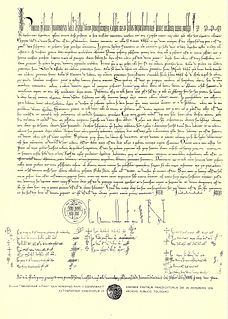
Religiosam vitam is the incipit designating a Papal bull issued on December 22, 1216 by Pope Honorius III. It gave universal recognition to the Dominican Order. The Order already had monasteries in Rome, Paris and Boulogne and had already been locally recognized by the bishop of Toulouse the year before - its creation had coincided with the Albigensian Crusade in southern France, in whose support the Dominicans had been very active. It adopted the rule of St Augustine, but was also regulated by rulings and decisions taken by regular general chapters.

The Roman Catholic Diocese of Mende is a diocese of the Latin Rite of the Roman Catholic Church in France. The diocese covers the department of Lozère.

The former Roman Catholic Diocese of Oloron was a Latin rite bishopric in Pyrénées-Atlantiques department, Aquitaine region of south-west France, from the 6th to the 19th century.

The Roman Catholic Archdiocese of Dijon is a diocese of the Latin Rite of the Roman Catholic Church in France. The archepiscopal see is Dijon Cathedral, which is located in the city of Dijon. The diocese comprises the entire department of Côte-d'Or, in the Region of Bourgogne. Originally established as the Diocese of Dijon in 1731, and suffragan to the Archdiocese of Lyon, the diocese was elevated to the rank of archdiocese in 2002. The most significant jurisdiction change occurred after the Concordat of 1801, when the diocese annexed the department of Haute-Marne. In 1821, a Papal Bull re-established the Diocese of Langres. The current archbishop is Roland Minnerath, appointed in 2004.
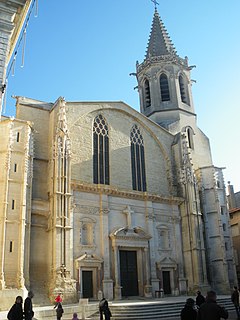
Carpentras was a diocese of the Roman Catholic Church in the Provence region, from the later Roman Empire until 1801. It was part of the ecclesiastical province under the Metropolitan, the Archbishop of Arles. The bishop was a major figure in the Comtat Venaissin, and a member of the Estates of the Comtat. He was a direct appointee of the pope.

The Roman Catholic Diocese of Bayonne, Lescar, and Oloron, commonly Diocese of Bayonne, is a suffragan diocese of the Latin Rite of the Roman Catholic Church in France in the ecclesiastical province of the Metropolitan Archdiocese of Bordeaux, in the administrative region Pyrénées-Atlantiques. The diocese comprises the Department of Pyrénées-Atlantiques, in the Region of Nouvelle-Aquitaine. Historically, at one time or another, the diocese belonged to the Dukes of Aquitaine, the Kings of England, the Kings of Navarre, and the Kings of Spain. The people are Basques, and the Basque language flourishes.

The Roman Catholic Diocese of Montauban is a diocese of the Latin Rite of the Roman Catholic Church in France. The diocese is coextensive with Tarn-et-Garonne, and is currently a suffragan of the Archdiocese of Toulouse. The episcopal seat of the Diocese of Montauban is in Montauban Cathedral.

Pierre Desprès was a French Cardinal during the period of Avignon Papacy. He was son of Raymond II Desprès, seigneur of Montpezat, and Aspasie de Montaigut, the heiress of Bertrand, seigneur de Montaigut. He had a brother, Raymond, who was ennobled in 1325. Pesserat points out that Montpezat was an important town, being the seat of the Archdeacon of Montpezat in the diocese of Cahors, who was also Sacristan of the Cathedral. Not at all coincidentally, Pope John XXII was a native of Cahors, and his father had been Sieur de Saint-Félix en Quercy. With his expertise in the law as a teacher and practitioner, and with his experience as a judge in the Roman Curia, Pierre Desprès was appointed Vice-Chancellor of the Church by John XXII, where he served from 1325 to 1361. He was thus head of the Papal Secretariat, in charge of the drafting of papal bulls and letters, and a principal papal advisor. The post was also one of the most lucrative in the Roman Curia, since a fee was charged for every document and the Vice-Chancellor received a share of every fee.
The du Quenoy family is a French noble house of medieval and chivalric lineage. Its origins are in Normandy. The family was first mentioned in a Papal Bull issued by Pope Alexander III, dated May 17, 1181, to acknowledge its endowment of the Priory of Saint-Lô du Bourgachard. Initially seigneurs and chevaliers, the family was raised to a barony by King Louis XIII in August 1636. The family produced generations of feudal lords, army officers, and numerous knights of royal orders. A cadet branch of the family, now extinct, was elevated to the rank of marquis in July 1714.


